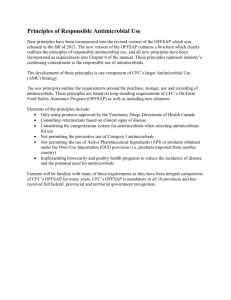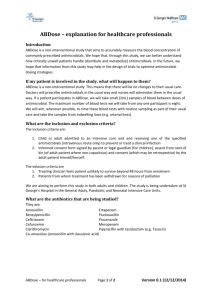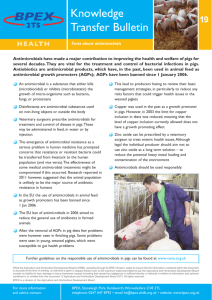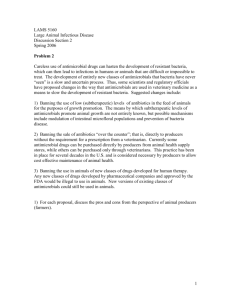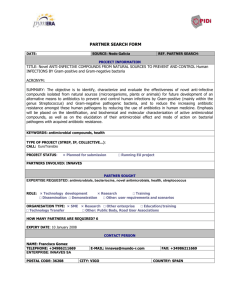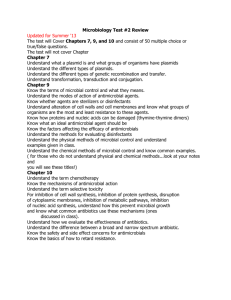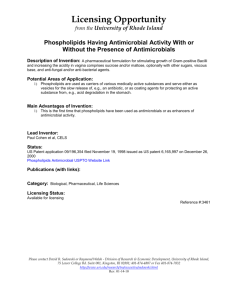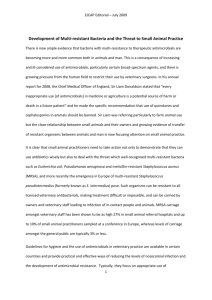proposal research paper
advertisement
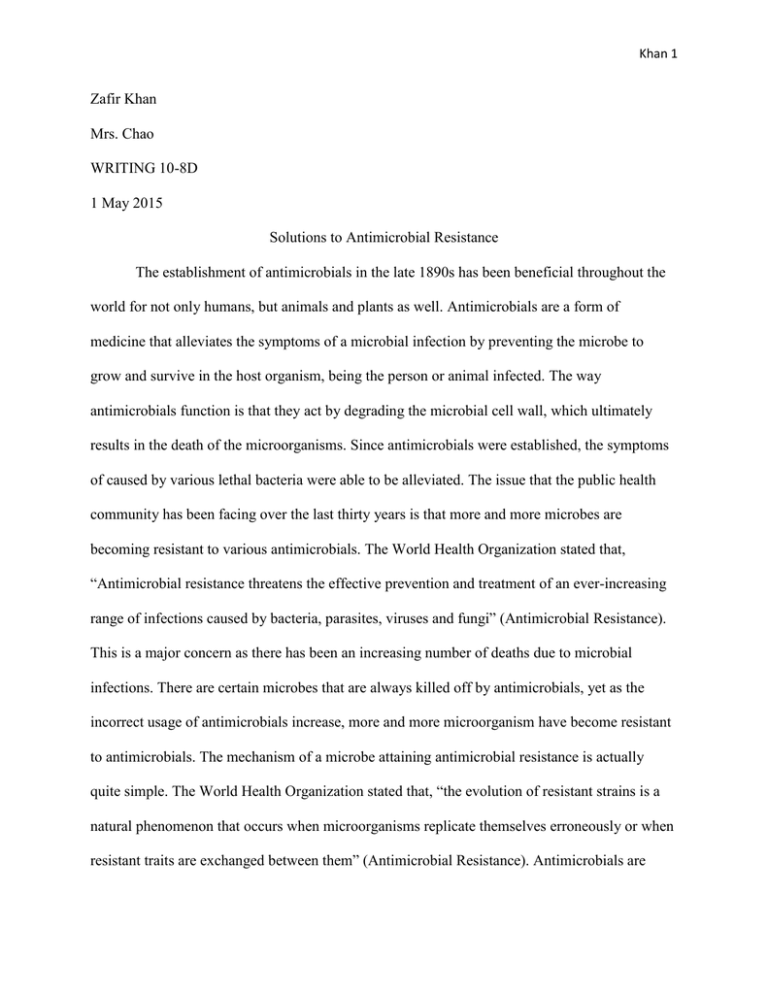
Khan 1 Zafir Khan Mrs. Chao WRITING 10-8D 1 May 2015 Solutions to Antimicrobial Resistance The establishment of antimicrobials in the late 1890s has been beneficial throughout the world for not only humans, but animals and plants as well. Antimicrobials are a form of medicine that alleviates the symptoms of a microbial infection by preventing the microbe to grow and survive in the host organism, being the person or animal infected. The way antimicrobials function is that they act by degrading the microbial cell wall, which ultimately results in the death of the microorganisms. Since antimicrobials were established, the symptoms of caused by various lethal bacteria were able to be alleviated. The issue that the public health community has been facing over the last thirty years is that more and more microbes are becoming resistant to various antimicrobials. The World Health Organization stated that, “Antimicrobial resistance threatens the effective prevention and treatment of an ever-increasing range of infections caused by bacteria, parasites, viruses and fungi” (Antimicrobial Resistance). This is a major concern as there has been an increasing number of deaths due to microbial infections. There are certain microbes that are always killed off by antimicrobials, yet as the incorrect usage of antimicrobials increase, more and more microorganism have become resistant to antimicrobials. The mechanism of a microbe attaining antimicrobial resistance is actually quite simple. The World Health Organization stated that, “the evolution of resistant strains is a natural phenomenon that occurs when microorganisms replicate themselves erroneously or when resistant traits are exchanged between them” (Antimicrobial Resistance). Antimicrobials are Khan 2 prescribed daily to patients across the United States, and used substantially in agriculture. In agriculture, farmers have implemented the usage antimicrobials to crops and animals to increase size and output. Farmers and everyday individuals can obtain antimicrobials from drug stores and agricultural based stores without a prescription. “The potent and more expensive antimicrobials require prescription, however in the case of agriculture, most antimicrobials are available without prescription” (CDC). It is important to implement a system in which antimicrobial distribution is monitored and limited. By limiting the distribution and unnecessary usage of antimicrobials in a hospital/clinical and agricultural setting, the increase in antibiotic resistance can be reduced, as well as prevented. The over distribution of antimicrobials in hospitals and clinical settings by physicians are a major reason in why antimicrobial resistance has increased. As more and more microbial infections occur, there is a greater need and demand for effective antimicrobials. The United States Center for Disease Control and Prevention noted that, “more than two million people in the U.S. get drug-resistant infections annually” (CDC). There are various reasons for why hospitals are a major source for increasing antimicrobial resistance. For instance, when a parent brings his/her child to visit the doctor regarding the condition of the child, the parent expects to leave with some form of medication. “The truth of the matter is that most of the time the child has a fever or some mild illness in which there is no need for antimicrobials” (Antibiotic Resistance Solutions Initiative). The parent demands that the child receives medication, and thus the physician is more inclined and pressured into prescribing antibiotics. This will only aid in microbes becoming more and more resistant to antimicrobials. According to the CDC, “pediatricians have also urged doctors to avoid giving antibiotics unless it is absolutely necessary, especially for ear infections and sinusitis” (CDC). This statement is not made to make Khan 3 it where physicians should never prescribe antimicrobials, but limit the practice of prescribing antimicrobials to only when it is required. The reason for this is that a microbe can become resistant upon being treated with antimicrobial that is not effective against it. This results in infectious diseases that cannot be treated, which results in the deaths of individuals. By making sure a patient only receives antimicrobials when he/she has a microbial infection will limit the spread and increase of microbial infection. Each time antimicrobial is used incorrectly, the microbes in the environment become more and more resistant to the given antimicrobials. In addition, it has been observed that patients most often will not complete the full dosage prescribed to them by their physician. The patient will start to see the symptoms caused by the microbe to fade, yet the microbe will not entirely die off. Thus this microbe will become resistant to the bacteria and reproduce. However, the main area of concern is prescribing the correct antimicrobial. According to the CDC, “up to 50 percent of antibiotics are prescribed incorrectly or to people who do not need them” (CDC). This is the major reason in why there needs to be a restriction on the amount of antimicrobials that can distributed, as well as an effective system in making the patient and parents understand that they do not need antimicrobials. It is very important for the medical community to educate and make the patient understand what antimicrobials are actually used for, as well as educating physicians on how to react when they are pressured into a situation in which the parent of a child is demanding some form of medication. In addition, the “development of next generation rapid susceptibility tests for drugresistant microbes” should be established in order to not only prevent unnecessary usage of antimicrobials, but prevent an epidemic (Antibiotic Resistance Solutions Initiative). With a system that makes patients understand the importance of only using antimicrobials when they Khan 4 have microbial infections, as well as understanding to take the full dosage of the prescribed antimicrobials, a future in which antimicrobial resistance is drastically low can be reached. In addition, antimicrobials have been excessively used in agriculture on crops and animals, which have played a prominent role in the increase in antimicrobial resistance. Most of the antimicrobials that are produced for agricultural and animal usage are available over the counter in most drug stores. According to the CDC, “the 2013 Threats report points out that according to data published by FDA, there are more kilograms of antibiotics sold in the United States for food-producing animals than for people. This use contributes to the emergence of antibiotic-resistant bacteria in food-producing animals” (Antibiotic Resistance Foodborne and Germs). This is alarming as most of the food humans consume on a daily basis comes from an agricultural setting. The animals that are grown on farms are subjected to antimicrobials as well. This only furthers antimicrobial resistance, as these crops and animals acts as carriers which transfer the antimicrobials into the immune systems of microbes. This is similar to physicians prescribing incorrect antimicrobials, as in this case the unnecessary antimicrobials will be processed by the microbes, which will give rise to the further development of antimicrobial resistance. Resistant bacteria can contaminate the foods that come from animals that serve as carriers of resistant bacteria, and people who consume these foods can develop antibioticresistant infections” (Antibiotic Resistance Foodborne and Germs). By consuming foods that have had antimicrobials administered to them, the spread of antimicrobial resistance is further spread. Microbes evolve and thus diversify among their various habitats, which make it very easy for them to evolve and adapt when exposed to an incorrect antimicrobial is administered to them. It is important to implement a system in which there are multiple restrictions on purchasing antimicrobials for plants and animals. The CDC mentions that “antibiotics that are Khan 5 medically important to treating infections in humans should be used in food-producing animals only under veterinary oversight and only to manage and treat infectious diseases, not to promote growth” (Antibiotic Resistance Foodborne and Germs). Since the availability for antimicrobials for crops and animals have been increased, the increase in people with microbial infections have also increased. For instance, the microbe listeria is commonly found in yogurt and ice cream. In 2010, there was an outbreak of listeria in Blue Bell frozen desserts. “148 people were reported with being infected, and 48 people died from that infection due to the fact there was no effective antimicrobial available at the time” (Antibiotic Resistance Threats Report and Foodborne Germs). After investigation, it was noted that the cows that the ice cream was produced from had had antimicrobials administered to them. Thus the products acted as carriers, which gave rise to the antimicrobial resistance of listeria. Pharmaceutical companies were later able to produce an effective antimicrobial to kill off listeria, yet it was too late. This is a major reason in why there needs to be restrictions on the usage of antimicrobials in food and crops, as a microbial outbreak could have been prevented. To prevent and limit the spread of antimicrobial resistance in agriculture, the United States should adopt a model similar to Sweden, and other European countries as Norway. “Agriculture in Sweden is more industrialized and there's more movement of food and animals across the borders. The Norwegian agriculture policy decreases the risk of developing resistant bacteria and a small import of animals and food create less spread of resistant microbes” (Sweden). The systems that are established in Sweden and most European countries are to educate farmers all over the country, and explain that agricultural output and financial profit will not decrease due to decreasing the usage of antimicrobials. This is very important, as “70% of infectious diseases in humans originate from animals”. (Sweden) Sweden and Norway have effectively lowered the annual rate of people dying from microbial infections. Khan 6 The system will educate farmers and any individual that desires to use antimicrobials to produce crops and animals that antimicrobials cause more harm than good. The system also restricts the amount of antimicrobials being distributed to a farmers, as well as annual inspections. It will be daunting task to convince farmers to decrease and even stop using antimicrobials on their crops and animals, yet by showing statistics and a model that actually works, the farmers should be inclined to follow the guidelines and principles of the system. Since the establishment of antimicrobials, humankind has benefited a great deal from using antimicrobials to treat microbial infections. However, due to over using and incorrectly using antimicrobials, microbes have evolved and developed resistance to an array of antimicrobials. This has proved to be a major public health concern throughout the world, as more and more people are becoming infected with microbes that are resistant to a variety of antimicrobials. Thus, there is an increasing number of deaths due to there not being any effective antimicrobials to treat the microbial infections. These multi-drug resistant microbes originated from hospital and agricultural settings. From not understanding what the improper usage of antimicrobials can cause, more and more microbes become multi-drug resistant. The methods and systems that have been proposed in this paper offer solutions to decrease the percentage of antimicrobial resistance and even possibly prevent antimicrobial resistance. By implementing systems in which antimicrobial usage is limited, as well as educating the general population on the proper usage of antimicrobials, a world in which antimicrobial resistance is a not a major public health concern can be attained. Khan 7 Works Cited “Antimicrobial Resistance.” WHO. N.p., n.d. Web. 04 Apr. 2015 “Antibiotic Resistance Solutions Initiative.” Centers for Disease Control and Prevention. Centers for Disease Control and Prevention, 06 Feb. 2015. Web. 04 Apr. 2015. "Antibiotic Resistance Threats Report and Foodborne Germs." Centers for Disease Control and Prevention. Centers for Disease Control and Prevention, 14 Apr. 2014. Web. 06 Apr. 2015. "CDC: Hospitals Major Source of Antibiotic-resistant Infections." CBSNews. CBS Interactive, n.d. Web. 06 Apr. 2015. Spellberg, Brad, Robert Guidos, David Gilbert, John Bradley, Helen Boucher, John Bartlett, and John Edwards. "Clinical Infectious Diseases." The Epidemic of Antibiotic-Resistant Infections: A Call to Action for the Medical Community from the Infectious Diseases Society of America. N.p., n.d. Web. 04 Apr. 2015. "Sweden Uses the Fewest Antibiotics in Food Production." EurActiv. N.p., n.d. Web. 06 Apr. 2015.
